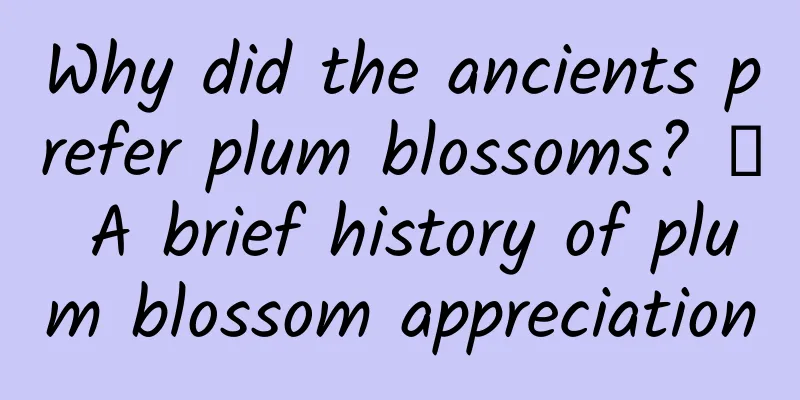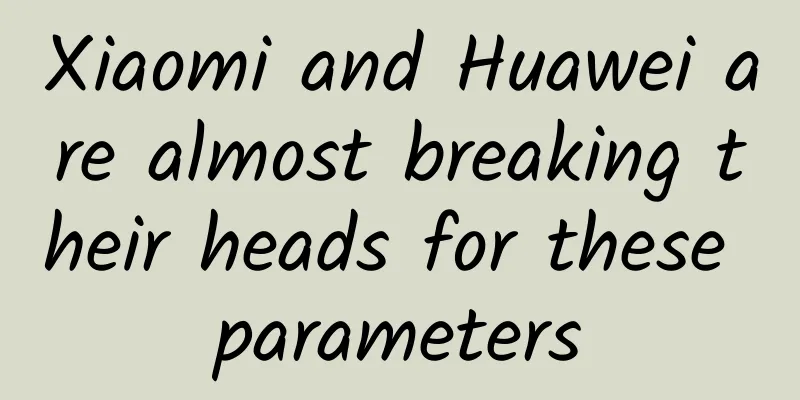Why did the ancients prefer plum blossoms? 丨 A brief history of plum blossom appreciation

|
Produced by: Science Popularization China Author: Li Bo (Shaanxi Institute of Biological Agriculture) Producer: China Science Expo "Where the flower of love blooms, life can flourish." Van Gogh once said. Since ancient times, beautiful love has been one of the most desired happiness for mankind, and using flowers to symbolize love has become a consensus in Eastern and Western cultures. Many plants, such as roses, albizzia, osmanthus, lilies, and forget-me-nots, have been given different images of love. However, in China, the earliest flower used to express love was not these, but plum blossom. The Book of Songs, Zhaonan, Picking Plum Blossoms, states: There are plum blossoms, and they have seven fruits. Seek my common people, and wait for the good fortune! There are plum blossoms, three of them! Seek my common people, wait until now! Pick some plum blossoms and put them in a basket! Seek my common people, and wait for them to do so! This poem uses the decreasing number of plum fruits remaining on the tree as a timeline to describe the girl's desire for love. The falling of plum fruits from the tree is like the passing of the girl's youth, which is very touching. The poem is short in words and the language is not gorgeous, but it depicts the girl's true emotions of spring love and longing for love in a delicate, vivid and vivid way. Among the 305 poems in the Book of Songs, there are no less than a hundred kinds of plants involved. Why did our ancestors choose plum blossoms to express their love? Let me explain. You can make a soup with salt and plums As an authentic native species, the description of plum in Flora of China is as follows: Plum (Armeniaca nume), Rosaceae, genus Armeniaca, native to southern China, now cultivated in various places, especially in provinces south of the Yangtze River. It is also widely planted in Japan, South Korea and other places that are deeply influenced by Chinese culture. As a common local plant, the history of plum being eaten by our ancestors can be traced back to ancient times. Scientists found the fruit pits left after the ancients ate plums in the Neolithic site of Peiligang in Xinzheng, Henan. After determining the C14 isotope, it was found that the history is more than 7,000 years old. Plums usually bear fruit in May and June. The fruit is nearly spherical, 2-3 cm in diameter, yellow or greenish-white, covered with soft hairs, and sour in taste. (Photo credit: Xunlu Lu Photography) The fruit of plum is usually called plum or green plum, but compared with its close relatives such as peach, plum and apricot, plum is smaller and tastes sour, making it difficult to eat directly. So, our clever ancestors came up with a solution - use it as a condiment. In the Book of History, it is recorded that "when making soup, you should use plums with salt", which means to use it as vinegar. People today have invented better ways to make food taste sour, but the Bai people in Dali, Yunnan and the Naxi people in Lijiang still retain the traditional cooking method of stewing chicken and meat with plums. Food lovers may wish to try it when they go to Yunnan. After the Han Dynasty, our ancestors' ability to eat plums increased. Pickling, drying, and storing in honey became the mainstream method of eating dried plums. In the "Mao Shi Cao Mu Niao Shou Chong Yu Shu" written by Lu Ji during the Three Kingdoms period, plums were described as follows: "Boil and dry them to make preserved fruits, put them in soups, stews, and minced meats. They can also be eaten with honey." The so-called fragrant mouth means holding it in the mouth to remove the odor, which is somewhat similar to people eating betel nuts today. In the process of eating plums, the medicinal value of plums has been gradually discovered. As early as the Han Dynasty, the "Shennong Bencao Jing" proposed that plums are sweet and mild in nature, and have the effect of astringing and promoting body fluid. Li Shizhen's "Compendium of Materia Medica" also clearly recorded that plums can calm the mind, quench thirst, relieve cough, stop typhoid fever and irritability, reduce swelling and detoxify. Since the Southern and Northern Dynasties, people have begun to use black plums (nearly ripe plums smoked with fireworks) to make black plum drink, which can not only promote salivation and quench thirst, stimulate the appetite and relieve depression, but also relieve coughs and hangovers. After thousands of years, it is still one of the most popular cooling drinks in the hot summer. The earliest method of making sour plum soup comes from the "Records of the Lost History of Daye" written by Du Bao in the Tang Dynasty, which calls it "Wumei Drink". (Photo source: veer photo gallery) Although plums can be eaten, quench thirst, and used as medicine, they are not really good fruits. It seems that it is precisely because they are not suitable for eating alone that the story of Cao Mengde discussing heroes over plum wine came into being. Leaning against the door, looking back and smelling the green plums Whether it is for making soup, eating or cooking wine, you need to use mature plums. And those green plums that have not yet grown up and matured are not idle either. They became rare game props for the ancients. Li Bai's "Two Poems of Changgan" has the best interpretation of "The boy rides a bamboo horse and plays with green plums around the bed. Living together in Changgan, the two children have no suspicion of each other." Li Qingzhao is even more brilliant, "Seeing someone coming, she scratches her gold hairpin with her socks. She walks away shyly, leans against the door and looks back, but smells the green plums." (From "Dian Jiang Lip") By playing with the green plums in her hands, the shy and curious girl's feelings when she first falls in love are instantly brought to life on paper. In the southern part of the middle and lower reaches of the Yangtze River in China, there will be continuous rain from mid-to-late June to the first half of July every year. This is the time when plums are ripe, so it is called the plum rain season. (Photo source: veer photo gallery) In addition to being used for games, plums have also established a deep connection with phenology and meteorology. Because from June to July every year, when plums are ripe, it is always rainy in the south of the Yangtze River. Over time, people have associated plums with rainy weather, and thus the specific meteorological name "plum rain" has been created. Only with plum blossoms can things be different If the fruit of the plum has left a mark in Chinese culture because of "salted plum", "edible plum", "playing with plum" and "plum rain", then this influence is really insignificant compared to that of the plum blossom. Like peach, pear, apricot and plum, plum blossoms, which belong to the Rosaceae family, are also fragrant and beautiful. While eating fruits to meet material needs, ancient people also began to seek spiritual comfort from the natural beauty of plum blossoms. The earliest record of plum variety selection can be traced back to the "Xijing Miscellaneous Records" of the Han Dynasty, which recorded the cultivation of multiple varieties of plum blossoms such as "Houmei, Tongxinmei, Zihuamei" in Shanglin Garden. As can be seen from the names, the basis for their naming is more or less related to the nature of the flowers. Plum blossoms bloom in early spring and have a strong fragrance. The calyx is usually reddish brown, the petals are obovate, white to pink, and the stamens are short or slightly longer than the petals. (Photo credit: Photo taken by the author) Before the Han Dynasty, artificially cultivated plums were rare and were mainly grown in royal courtyards. After the Wei and Jin Dynasties, the Chinese people migrated southward, and plum blossoms, which were common in the south of the Yangtze River, quickly became a frequent guest in the writings of scholars. They not only planted plum blossoms in garden nurseries, but also began to pay attention to the plum blossoms' fragrance, cold resistance, and spring-welcoming characteristics, and praised them. The famous line of the Southern Dynasty poet Lu Kai, "I have nothing in the south of the Yangtze River, so I give you a branch of spring", shows that the plum blossom at that time had surpassed the image of expressing love in ancient times and became a beautiful symbol of friendship and family affection. By the Tang and Song dynasties, the ancients' love for plum blossoms reached its peak. Among the Tang and Song poems circulating today, there are more than 400 poems praising plum blossoms. Many great writers such as Li Bai, Bai Juyi, Su Shi, and Lu You were all its fans. It can be said to be the best partner for literati and poets. The Southern Song Dynasty literary giant Fan Chengda's love for plum blossoms reached an unprecedented level. The opening line of "Fancun Plum Blossoms" compiled by him is: "Plum blossoms are the most beautiful creatures in the world. No one, wise or foolish, dares to object to their love..." There is a sense of domineering president's aura between the lines between the lines, making it worthy of being the world's first monograph on plum blossoms. Because of their love for plum, even wintersweet received special attention from the ancients. However, wintersweet (Chimonanthus praecox) belongs to the Calycanthaceae family, Chimonanthus genus, and is completely unrelated to plum. The reason why it was named wintersweet is clearly explained in the "Fancun Plum Book": "Wax plum is not originally a plum, but because it grows at the same time as plum, has a similar fragrance, and its color resembles honey, it is named wintersweet." This shows that although the ancients did not understand modern plant taxonomy, they were very good at observation. Wintersweet is often mistaken for a close relative of plum because of its similar flowering period and flower shape to plum. (Photo source: Xunlu Photo) It is disrespectful to call him the King of Flowers Shelley wrote in "Ode to the West Wind": "Winter is here, can spring be far behind?" Plum blossoms bloom at the turn of winter and spring. Although it is the coldest time of the year, the beautiful flowers bring people joy and hope for the coming of spring. Among all the poems about plum blossoms throughout the ages, my favorite is Mao Zedong's "Bosuanzi: Ode to the Plum Blossom", "The cliff is a hundred feet of ice, yet the flowers are still beautiful. Their beauty does not compete for spring, but only announces the arrival of spring." These two simple sentences perfectly embody the characteristics of plum blossoms welcoming spring and the revolutionaries' fearless optimism. The plum blossoms that bloom proudly in the snow have become a model of gentlemanly character in traditional culture (Photo source: Xunlu Photo) Since plum blossoms bloom before leaves, they usually bloom in frost and snow, when everything has not yet recovered, and only plum blossoms stand proudly in the wind and snow. This scene makes its noble character of defying frost and snow and persevering perseverance particularly prominent, and plum blossoms have become a symbol of noble character praised by literati in successive dynasties since the Song Dynasty. Compared with the ornamental value of the natural beauty of plum blossoms, the personality characteristics endowed by plum blossoms make them unique among various flowers and plants. Therefore, plum blossoms are also called the "Four Gentlemen" along with orchids, bamboos, and chrysanthemums, which symbolize the character and spirit of the Chinese nation. Conclusion Since the poem “Picking Plum Blossoms”, plum blossoms have established a close relationship with the Chinese nation. After thousands of years, they have created our unique and brilliant culture. The value and character of plum blossoms have also been carried forward and passed down because of the great wisdom of the Chinese nation. In fact, there are many beautiful natural creations like plum blossoms around us, and their value and character are waiting for us to discover, explore and promote. Acknowledgements: We would like to thank Mr. Xun Lulu from Xi'an Botanical Garden for providing a large number of precious photos and valuable suggestions for writing this article. References 1. Luo Guihuan. A brief study of Mei Shi. Journal of History of Natural Sciences, 2013, 32 (1): 64-71 2. Lu Ji. Mao Shi: Plants, Birds, Beasts, Insects and Fishes, Beijing. Zhonghua Book Company, 1985. 3. Wu Zhenyu. "The Book of Songs Picking Plum Blossoms" from the Perspective of Folk Symbols. Chinese Characters and Historical Culture, 2018, 24:123-125 4. Zhang Minghua. Plum and Poetry. Jinan University Press, 2018 5. Li Qingwei. Research progress of plum. Journal of Beijing Forestry University, 2004, Vol.26 Supp:116-122 6. Yang Xiangtao. Aesthetic characteristics of plum blossoms and artistic creation of garden water bodies. Forestry Survey and Planning, 2015, 40 (4): 158-160 7. Gao Zhihong et al. Research progress on plum planting resources and molecular biology. Journal of Nanjing Agricultural University, 2019, 42 (6): 875-985 8. Cheng Xiaojian et al. Research progress on plum variety classification. Journal of Zhejiang Agricultural Sciences, 2002, 14 (2): 120-124 9. Shao Jing et al. Study on the pharmacological effects of plum. Jiangsu Forestry Science and Technology, 2011, 38 (4): 44-47 |
<<: When you can’t help wanting to eat, are you just craving for food or are you really hungry?
>>: Clear waves protect the central axis. How did the water system of the central axis evolve?
Recommend
Beware! There are as many as 6,000 parasites! Don't touch this thing if you see it
These past few days A Shenzhen resident discovere...
5 obstacles that new programmers must overcome
Many people want to become a programmer or switch...
When the New Year’s Eve dinner has a “chief commander”, the living room instantly turns into a New Year’s film set. Who makes the New Year atmosphere last longer?
"Xiao X, Xiao X, turn up the volume of Good ...
Is the effect of bidding promotion declining? You must analyze these 8 factors
Nowadays, most of our SEM promotions revolve arou...
Can we see the past of the Milky Way through a telescope?
The light-time equivalence mentioned here is not ...
For every extra hour you sit, a slim waist disappears from the world
Friends, are you sitting now? Do you know that &q...
Is there a bug in iOS 17.5? Users’ private photos reappear after being deleted!
This Tuesday, Apple pushed an update to the offic...
How much does it cost to develop the Datong Jewelry Mini Program?
What is the price for developing Datong Jewelry M...
Google AdWords account opening process and account building
If you want to advertise, you absolutely need to ...
Does the Mini Program need to have a store nearby? Does the Mini Program have to have a physical store?
Q: Does the Nearby Mini Program need to have a st...
Gartner: Apple's global smartphone market share dropped to third place in the first quarter
Against the backdrop of a shrinking global smartp...
Chongqing flood losses exceed 2.4 billion
Chongqing flood losses exceed 2.4 billion Zou Yu,...
Yuzhou SEO training: Although SEO optimization mutual clicks can promote rankings, the use of SEO mutual click software is not conducive to
SEO mutual points has always been a topic discuss...
Do you really understand colds?
When it comes to colds, everyone knows about it. ...
2022 Silicon Valley Java Employment Class
2022 Silicon Valley Java Employment Class Resourc...









